
Trellick Tower is a Grade II* listed tower block on the Cheltenham Estate in North Kensington, London. Opened in 1972, it was commissioned by the Greater London Council and designed in the Brutalist style by architect Ernő Goldfinger. The tower was planned to replace outdated social accommodation, and designed as an improvement on Goldfinger's earlier Balfron Tower in East London. It was the last major project he worked on, and featured various space-saving designs, along with a separate access tower containing a plant room.
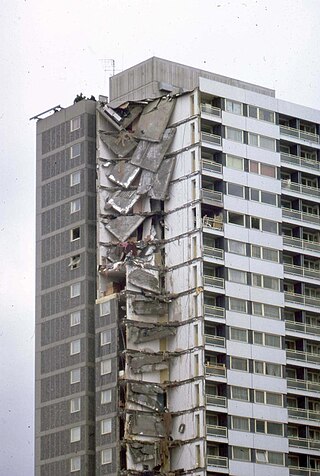
Ronan Point was a 22-storey tower block in Canning Town in Newham, East London, that partly collapsed on 16 May 1968, only two months after it had opened. A gas explosion blew out some load-bearing walls, causing the collapse of one entire corner of the building; four people died and 17 were injured. The nature of the failure led to a loss of public confidence in high-rise residential buildings, and major changes in British building regulations resulted.
The Lakanal House fire occurred in a tower block on 3 July 2009 in Camberwell, London. Six people were killed, and at least twenty injured, when a high-rise fire, caused by a faulty television set, developed and spread through a number of flats in the twelve-storey building.
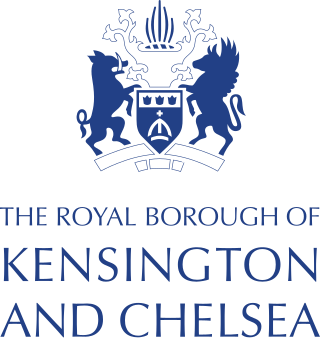
Kensington and Chelsea London Borough Council, also known as Kensington and Chelsea Council, is the local authority for the Royal Borough of Kensington and Chelsea in Greater London, England. It is a London borough council, one of 32 in London. The council has been under Conservative majority control since its creation in 1965. It is based at Kensington Town Hall.

Kensington and Chelsea TMO (KCTMO) was the largest tenant management organisation (TMO) in England, managing nearly 10,000 properties on behalf of Kensington and Chelsea London Borough Council – the entire council housing stock in the Royal Borough of Kensington and Chelsea.

Kensington Aldridge Academy (KAA) is an 11–18 co-educational secondary school with academy status in the North Kensington area of the Royal Borough of Kensington and Chelsea, in London, England. KAA opened in September 2014, and was officially opened by Catherine, Duchess of Cambridge in January 2015. The Academy's sixth form opened in September 2016. The school specialisms are Entrepreneurship and Creative & Performing Arts.

On 14 June 2017, a high-rise fire broke out in the 24-storey Grenfell Tower block of flats in North Kensington, West London, at 00:54 BST and burned for 60 hours. Seventy people died at the scene, and two people died later in hospital, with more than 70 injured and 223 escaping. It was the deadliest structural fire in the United Kingdom since the 1988 Piper Alpha oil-platform disaster and the worst UK residential fire since the German Bombings of World War II.

Lancaster Road (West) Estate is a housing estate in North Kensington, west London.
Samuel Webb was a British architect who was famous for his work on the structural and fire safety of Tower Blocks following his investigation into the Ronan Point tower block.

Tower blocks are high-rise buildings for residential use. These blocks began to be built in Great Britain after the Second World War. The first residential tower block, "The Lawn", was constructed in Harlow, Essex, in 1951; it is now a Grade II listed building. In many cases, tower blocks were seen as a "quick-fix" to cure problems caused by the existence of crumbling and unsanitary 19th-century dwellings or to replace buildings destroyed by German aerial bombing. It was argued that towers surrounded by public open space could provide for the same population density as the terraced housing and small private gardens they replaced, offering larger rooms and improved views, whilst being cheaper to build.

The Harrow Court fire occurred in a tower block on 2 February 2005 in Stevenage, Hertfordshire, England. Three people were killed, two of them firefighters, when a fire developed and spread from the 14th floor. An investigation of the fire found that there was an Abnormal Rapid Fire Development, caused by a candle melting the surface of a television, which then spread rapidly up the outside of the building to subsequent floors.
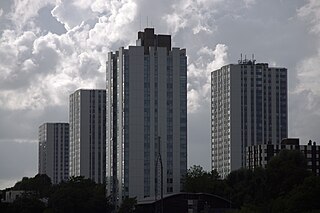
Chalcots Estate is a council housing estate on Adelaide Road and Fellows Road in Swiss Cottage in the London Borough of Camden. It was designed by Dennis Lennon and Partners. The Chalcots Estate was built on land owned by Eton College, which is reflected in the names of the individual buildings.

Rydon is a British facilities management and property maintenance company which was founded in 1978. Its head office is in Dartford, Kent, and it has two maintenance offices in London. It had a turnover of around £51.9 million and employed an average of 423 people in the year to September 2022.
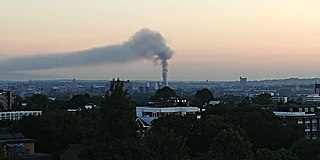
The Grenfell Tower Inquiry is a British public inquiry into the Grenfell Tower fire, which killed 72 people and destroyed Grenfell Tower on 14 June 2017. It was ordered by Prime Minister Theresa May on the day following the fire.
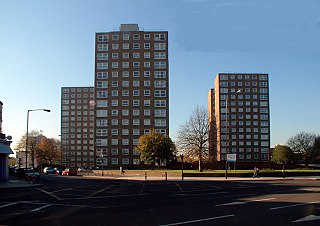
The Ledbury Estate is a large estate of social housing, in Peckham in the London Borough of Southwark. The estate is just south of the Old Kent Road, part of the A2 4 kilometres (2.5 mi) from both Tower Bridge and the Elephant & Castle it is adjacent to land used by George Livesey for the South London Gasworks.
Grenfell United is a pressure group made up of the families of victims and survivors of the 2017 Grenfell Tower fire. The first formal meeting of Grenfell United took place on Saturday 24 June 2017. The minutes read: “Residents are not present as individuals. They must organise and they must establish a structure.” They had been convened by Father McTernan, a local Irish priest, who had worked for decades in conflict resolution.
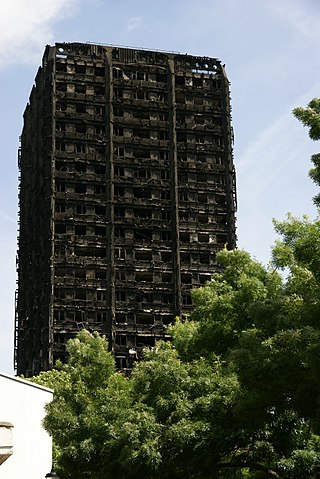
On 14 June 2017, the Grenfell Tower fire broke out in the 24-storey Grenfell Tower block of flats in North Kensington, West London, at 00:54 BST; it caused 72 deaths, including those of two victims who later died in hospital. More than 70 others were injured and 223 people escaped. It was the deadliest structural fire in the United Kingdom since the 1988 Piper Alpha disaster and the worst UK residential fire since the Second World War.
The Grenfell Tower Inquiry is a British public inquiry into the Grenfell Tower fire, which killed 72 people and destroyed Grenfell Tower on 14 June 2017. It was ordered by Prime Minister Theresa May on the day following the fire.
The Grenfell Tower Inquiry is a British public inquiry into the Grenfell Tower fire, which killed 72 people and destroyed Grenfell Tower on 14 June 2017. It was ordered by Prime Minister Theresa May on the day following the fire.

Criticism of the response to the Grenfell Tower fire primarily consisted of condemnation of issues with the emergency response and fire safety regulation practices in the UK at the time. Broader political criticism was also directed at British society, including condemnation of the response by governmental bodies and UK politicians, social divisions, deregulation issues, and poor transparency overall.























